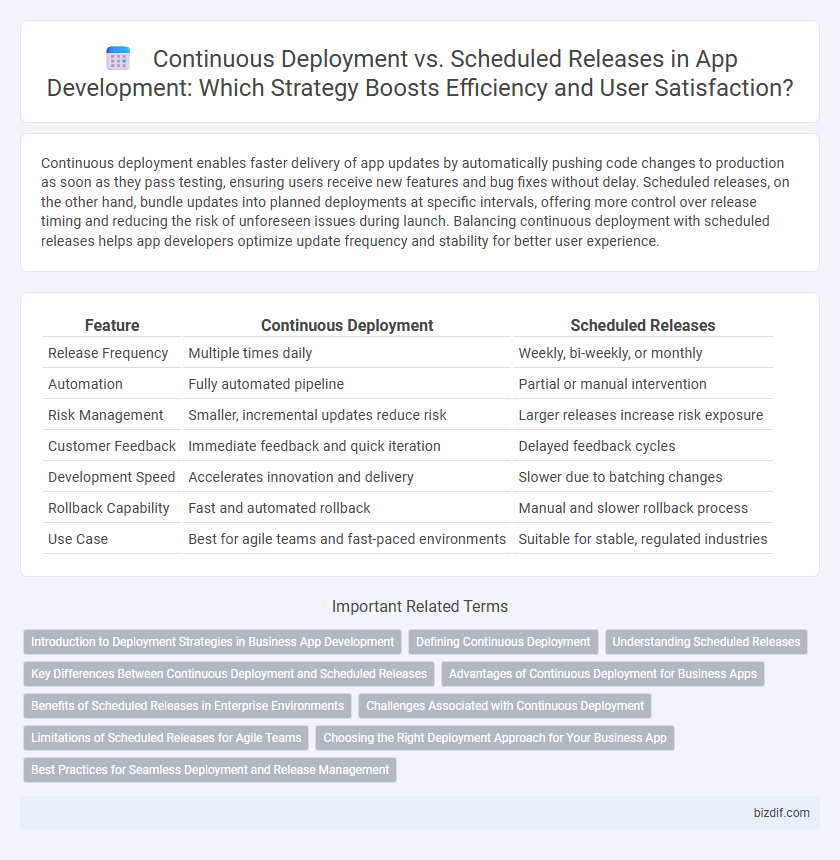Continuous deployment enables faster delivery of app updates by automatically pushing code changes to production as soon as they pass testing, ensuring users receive new features and bug fixes without delay. Scheduled releases, on the other hand, bundle updates into planned deployments at specific intervals, offering more control over release timing and reducing the risk of unforeseen issues during launch. Balancing continuous deployment with scheduled releases helps app developers optimize update frequency and stability for better user experience.
Table of Comparison
| Feature | Continuous Deployment | Scheduled Releases |
|---|---|---|
| Release Frequency | Multiple times daily | Weekly, bi-weekly, or monthly |
| Automation | Fully automated pipeline | Partial or manual intervention |
| Risk Management | Smaller, incremental updates reduce risk | Larger releases increase risk exposure |
| Customer Feedback | Immediate feedback and quick iteration | Delayed feedback cycles |
| Development Speed | Accelerates innovation and delivery | Slower due to batching changes |
| Rollback Capability | Fast and automated rollback | Manual and slower rollback process |
| Use Case | Best for agile teams and fast-paced environments | Suitable for stable, regulated industries |
Introduction to Deployment Strategies in Business App Development
Continuous Deployment accelerates software delivery by automatically releasing every validated code change to production, enabling rapid feedback and iterative improvements. Scheduled Releases bundle updates into planned, periodic deployments that offer stability and controlled rollouts, minimizing risks for mission-critical business applications. Selecting the appropriate deployment strategy depends on factors like development velocity, risk tolerance, and customer impact within enterprise app ecosystems.
Defining Continuous Deployment
Continuous Deployment automates the release process by immediately pushing code changes to production once they pass automated testing, ensuring rapid delivery and constant updates. It reduces manual intervention and accelerates feedback loops, enhancing product stability and user satisfaction. This approach contrasts with Scheduled Releases, which bundle updates for periodic deployment, potentially delaying feature availability and bug fixes.
Understanding Scheduled Releases
Scheduled releases provide a structured approach to app deployment by setting specific dates and times for updates, ensuring predictable delivery and reducing the risk of last-minute issues. This method allows development teams to coordinate testing, marketing, and support activities around release windows, enhancing overall workflow efficiency. By adhering to a fixed release schedule, businesses can better manage user expectations and maintain app stability.
Key Differences Between Continuous Deployment and Scheduled Releases
Continuous deployment automates the release of code changes immediately after passing tests, ensuring rapid delivery and continuous feedback, while scheduled releases bundle updates into predetermined intervals for more controlled deployment. Continuous deployment emphasizes agility and real-time iteration, reducing time-to-market and minimizing manual intervention, whereas scheduled releases prioritize stability and coordination, often aligning with business or marketing strategies. The choice between these approaches impacts development workflows, risk management, and resource allocation in app development environments.
Advantages of Continuous Deployment for Business Apps
Continuous Deployment accelerates the delivery of business app updates, enabling rapid response to market demands and user feedback, which enhances customer satisfaction and competitive advantage. Automated deployment pipelines reduce manual errors and downtime, ensuring consistent app performance and reliability. This approach supports agile development practices by allowing frequent, incremental improvements that drive innovation and operational efficiency.
Benefits of Scheduled Releases in Enterprise Environments
Scheduled releases in enterprise environments offer enhanced control over deployment timing, reducing the risk of disruptions during peak business hours. They enable coordinated rollout processes across multiple teams and systems, ensuring compatibility and stability. This approach supports compliance with regulatory requirements and aids in thorough testing and validation before public release.
Challenges Associated with Continuous Deployment
Continuous Deployment presents challenges such as increased risk of introducing bugs directly into production, requiring robust automated testing and monitoring systems to maintain application stability. Teams must also address the complexity of managing frequent updates, which can strain developer workflows and complicate rollback procedures. Ensuring seamless integration and coordination across development, QA, and operations becomes critical to prevent disruption in user experience during rapid release cycles.
Limitations of Scheduled Releases for Agile Teams
Scheduled releases often hinder Agile teams by reducing deployment frequency, limiting the ability to quickly iterate and respond to user feedback. The fixed timetable can cause bottlenecks in the delivery pipeline, delaying critical bug fixes and feature updates. This lack of flexibility conflicts with Agile principles of continuous improvement and rapid adaptation.
Choosing the Right Deployment Approach for Your Business App
Continuous deployment accelerates app updates by automatically releasing code changes, enhancing user experience through rapid feature delivery and bug fixes. Scheduled releases offer greater control and stability by bundling updates into planned cycles, reducing the risk of introducing errors during peak usage times. Selecting the right deployment approach depends on factors like team size, app complexity, user expectations, and risk tolerance to balance speed and reliability effectively.
Best Practices for Seamless Deployment and Release Management
Continuous Deployment enables rapid delivery by automatically pushing every code change to production, reducing lead time and accelerating user feedback. Scheduled Releases offer controlled deployment timing, which is beneficial for coordinating marketing, training, and minimizing risks during peak usage. Best practices include implementing robust automated testing pipelines, clear rollback procedures, thorough monitoring, and aligning release strategies with team capabilities and business goals to ensure seamless deployment and effective release management.
Continuous Deployment vs Scheduled Releases Infographic

 bizdif.com
bizdif.com